The Slow Cooker Korean Beef is a fantastic dish that brings together the rich, savory flavors of Korean cuisine with the convenience of slow cooking. Tender beef, sweet and spicy sauce, and aromatic seasonings combine to create a mouthwatering dish that is perfect for any occasion. Whether you’re serving it as a main course, a filling for tacos, or even in a bowl, this recipe will quickly become a family favorite.
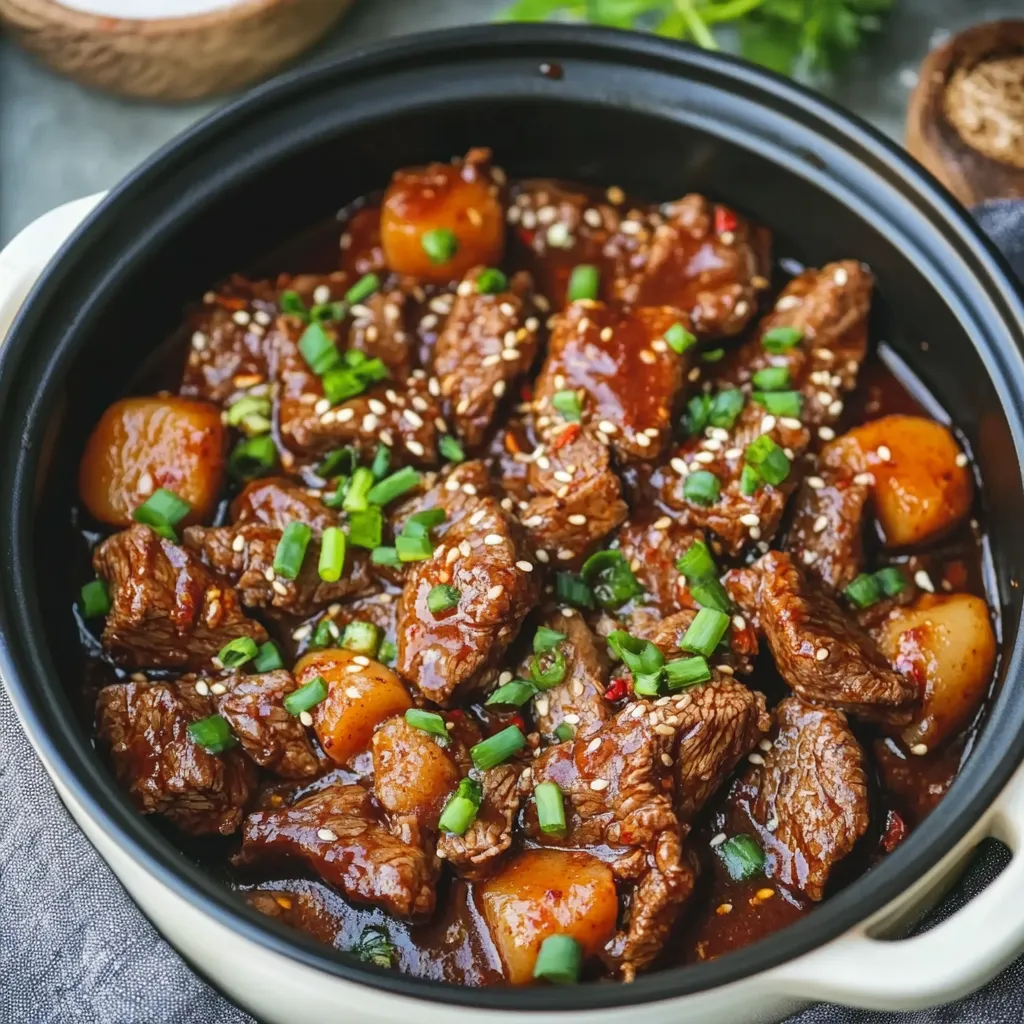
Why Use a Slow Cooker for Korean Beef?
Slow cookers are ideal for making dishes like Korean Beef because they allow the flavors to meld together and the meat to become tender over time. With minimal prep, you can walk away and let the slow cooker do the work, creating a dish that’s both flavorful and convenient.
The long cooking process in the slow cooker breaks down the collagen in the beef, resulting in tender, juicy pieces of meat that soak up the aromatic sauce, giving you a deeply satisfying dish. It’s also a hands-off approach that’s perfect for busy days when you want a delicious dinner waiting for you.
Key Ingredients for Slow Cooker Korean Beef
Here’s a list of essential ingredients you’ll need to make Slow Cooker Korean Beef. Each ingredient plays a key role in creating that signature Korean flavor profile:
-
Beef Chuck Roast: The best cut for this dish, as it has enough fat to keep the beef tender while slow cooking.
-
Beef Broth: Used to form the base of the sauce and add depth of flavor.
-
Soy Sauce: A must-have for the salty, savory base.
-
Gochujang Sauce: The key ingredient for spice, gochujang is a fermented chili paste that brings both heat and sweetness to the dish.
-
Sesame Oil: Adds richness and a hint of nuttiness.
-
Rice Vinegar: Provides a balance of acidity and helps cut through the richness of the beef.
-
Garlic and Ginger: Freshly minced garlic and ginger infuse the dish with fragrant, aromatic flavors.
-
Brown Sugar: Adds sweetness to balance the heat from the gochujang and savory notes from the soy sauce.
-
Cornstarch: Used to thicken the sauce at the end of cooking.
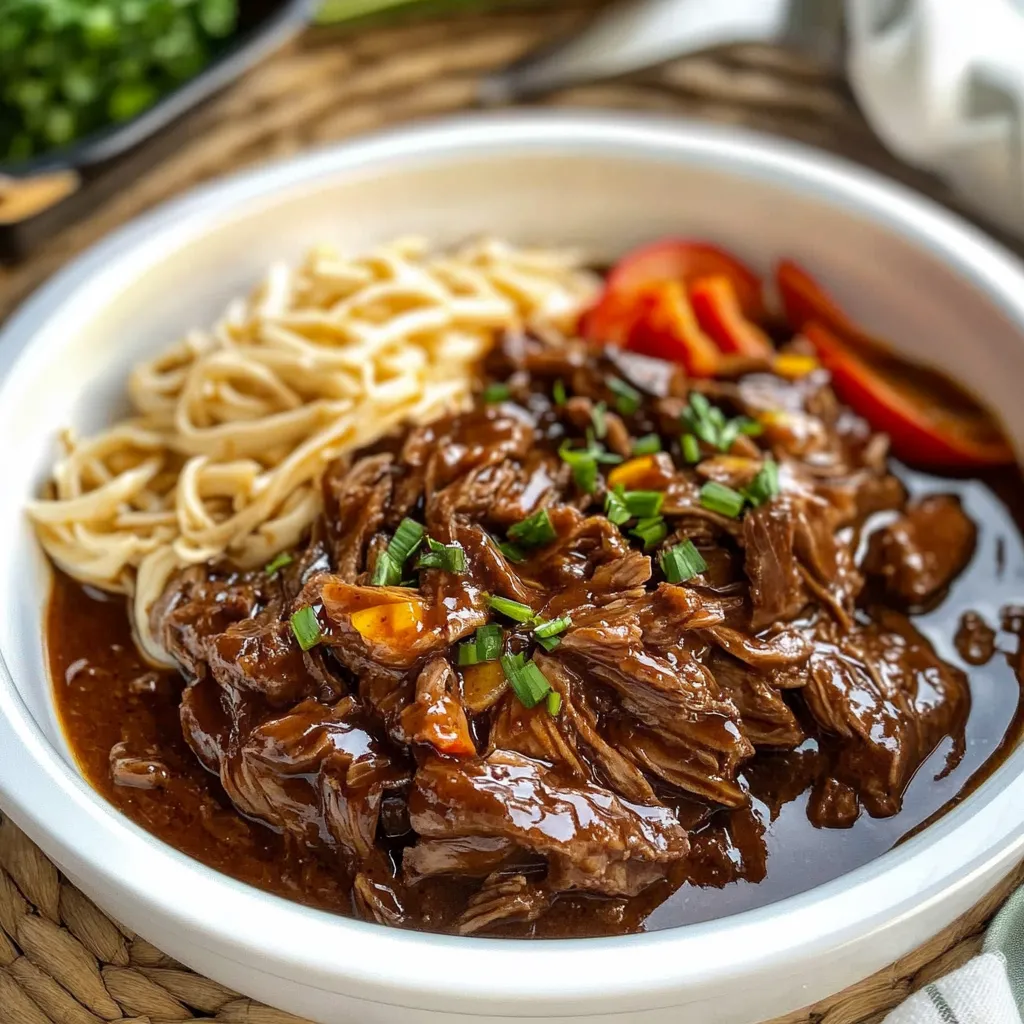
How to Make Slow Cooker Korean Beef
Making Slow Cooker Korean Beef is simple, and the process can be broken down into just a few steps:
Step 1: Prepare the Sauce
In a medium bowl, whisk together the beef broth, soy sauce, brown sugar, garlic, ginger, sesame oil, rice vinegar, and gochujang sauce. This flavorful mixture will become the base for your slow-cooked beef.
Step 2: Add Beef to the Slow Cooker
Cut the beef chuck roast into 1-inch cubes. While a whole roast works too, cutting it into cubes helps the beef cook faster and ensures each piece absorbs more flavor. Place the cubed beef into the slow cooker.
Step 3: Pour the Sauce Over the Beef
Once the beef is in the slow cooker, pour the prepared sauce mixture over it. Use a spoon to ensure the beef is evenly coated with the sauce. This will allow the beef to absorb all the savory, sweet, and spicy flavors as it cooks.
Step 4: Cook the Beef
Cover the slow cooker and cook on low for 6-8 hours. If you’re in a rush, you can cook it on high for 4-5 hours. The slow cooking time will break down the beef, making it tender and flavorful.
Step 5: Thicken the Sauce
After the cooking time is up, the sauce will be flavorful but might need a bit of thickening. In a small bowl, whisk together the remaining beef broth and cornstarch. Stir this mixture into the slow cooker and cook on high for an additional 30 minutes until the sauce has thickened to your desired consistency.
Step 6: Serve and Enjoy
Once the sauce has thickened, give the beef a final stir. The beef should be so tender that it falls apart easily. Serve your Slow Cooker Korean Beef over steamed rice, in tacos, or even in bowls with some fresh vegetables like carrots, cucumbers, or steamed broccoli. For extra flavor, top with sesame seeds and sliced green onions.
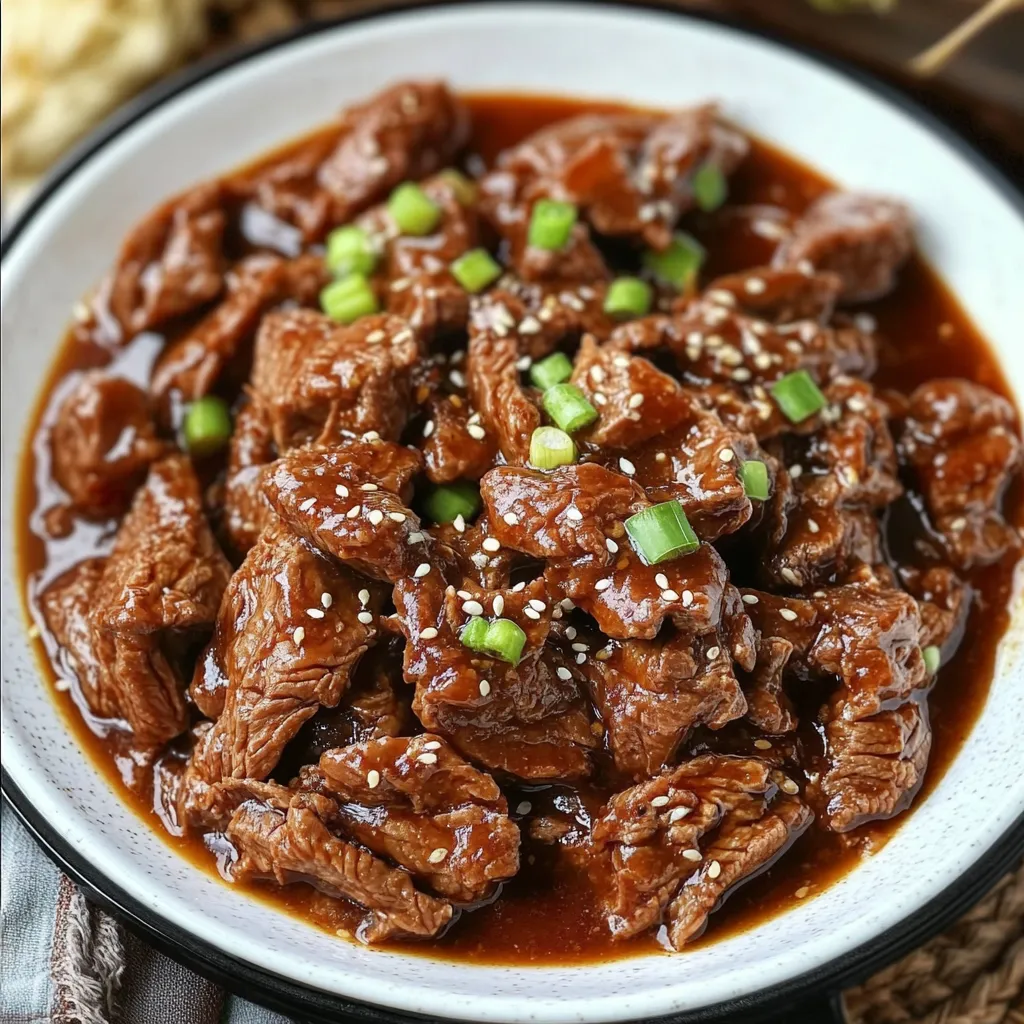
Recipe Tips for the Best Slow Cooker Korean Beef
-
Cut of Beef: Use a beef chuck roast, as it’s the best cut for slow cooking. Its marbling of fat helps create a tender, juicy dish. Avoid lean cuts like flank steak, as they won’t give you the same tender results.
-
Gochujang Sauce: Make sure to use gochujang sauce rather than gochujang paste. The sauce version has a balanced heat and sweetness, perfect for this dish. If you can’t find gochujang sauce, you can substitute with a mixture of soy sauce, a little sriracha, and brown sugar, but it won’t have the same depth of flavor.
-
Adjust the Spice Level: The amount of gochujang you use can be adjusted based on your spice tolerance. If you prefer a milder dish, start with 1 tablespoon of gochujang and taste the sauce before adding more.
-
Serving Suggestions: For a complete meal, serve the beef over rice, add a side of steamed vegetables, or use it in tacos with fresh slaw. You can also top the dish with sesame seeds and green onions for added flavor and texture.
Benefits of Slow Cooker Korean Beef
There are several reasons why Slow Cooker Korean Beef is a fantastic addition to your recipe repertoire. Here are just a few of the benefits of making this dish:
1. Convenience and Time-Saving
One of the biggest advantages of using a slow cooker is the convenience it offers. You can prep the ingredients in the morning, set the slow cooker, and let it do all the work while you go about your day. The long, slow cooking process ensures that the flavors develop to their fullest, without requiring you to stand over the stove.
2. Tender and Flavorful Beef
The slow cooking process breaks down the beef’s connective tissues, making it incredibly tender. Whether you use a chuck roast or another cut, the result will be melt-in-your-mouth beef that is full of rich, savory flavors. This is a key factor that makes this dish stand out compared to quicker cooking methods.
3. Customizable for Dietary Preferences
Slow Cooker Korean Beef is adaptable to suit different dietary needs. If you’re looking for a healthier version, you can swap out the brown sugar for a sugar substitute or use a lower-sodium soy sauce. Additionally, for those following a gluten-free diet, ensure you use a gluten-free soy sauce or tamari sauce. It’s easy to adjust this recipe based on what you have available or your specific needs.
4. Perfect for Meal Prep
This dish works wonderfully for meal prep. Since the recipe makes a large batch, it can be stored and used for multiple meals. Leftovers can be kept in an airtight container in the fridge for up to 4 days, or frozen for up to 3 months. The flavors actually improve after a day or two, so this is a great recipe to make ahead of time.
5. Impressive Yet Simple
Despite its incredible depth of flavor, this dish is quite simple to prepare. With only a few ingredients, the slow cooker does most of the heavy lifting. Whether you’re cooking for a family dinner or preparing something to impress guests, this dish makes a big impact with minimal effort.
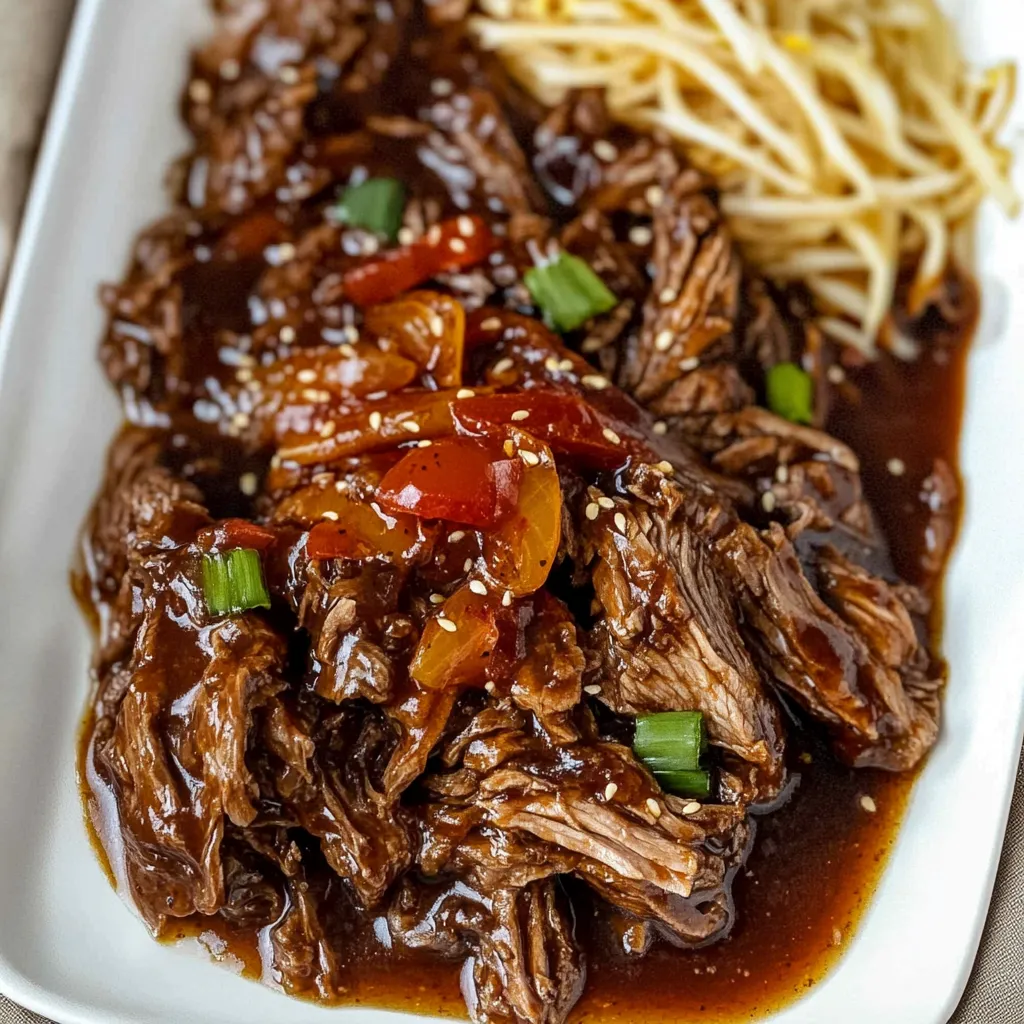
Nutritional Information for Slow Cooker Korean Beef
Here’s the nutritional breakdown for Slow Cooker Korean Beef, so you can enjoy the dish knowing exactly what you’re eating:
| Nutrient | Amount per serving (approx.) |
|---|---|
| Calories | 314 kcal |
| Protein | 27 g |
| Fat | 18 g |
| Saturated Fat | 7 g |
| Carbohydrates | 10 g |
| Sugar | 7 g |
| Sodium | 571 mg |
| Potassium | 538 mg |
| Cholesterol | 93 mg |
| Vitamin A | 20 IU |
| Iron | 3.2 mg |
This dish is a great source of protein and provides a decent amount of healthy fats. While it’s not the lowest in carbs due to the brown sugar and soy sauce, the dish offers a good balance of macronutrients. You can make it even healthier by reducing the sugar or using alternative sweeteners.
How to Serve Slow Cooker Korean Beef
This dish is incredibly versatile, and there are many different ways to serve Slow Cooker Korean Beef. Here are some of the most popular serving options:
1. Over Rice
The most traditional way to serve Slow Cooker Korean Beef is over a bed of steamed rice. Whether you use white rice, brown rice, or cauliflower rice, the rice soaks up all the delicious sauce, making it the perfect base for the tender beef. Add some steamed vegetables like broccoli, snow peas, or bok choy for extra flavor and nutrition.
2. In Tacos
For a fun twist, use the beef as a filling for tacos. Simply warm some flour tortillas, add the shredded Korean beef, and top with fresh cabbage slaw, cilantro, and a squeeze of lime. The combination of the spicy, sweet beef with the crunchy slaw is absolutely delicious.
3. Korean Beef Bowls
If you’re in the mood for something more like a deconstructed version of the dish, try serving the beef in a bowl with rice, thinly sliced cucumbers, julienned carrots, and a drizzle of extra sauce. This makes for a satisfying and filling meal that’s easy to customize with your favorite toppings.
4. On a Salad
For a lighter, low-carb option, serve the Slow Cooker Korean Beef on top of a salad. Use mixed greens or spinach and add additional toppings like avocado, shredded carrots, and a sesame dressing for a refreshing yet filling dish.
Tips for Perfecting Your Slow Cooker Korean Beef
To ensure your Slow Cooker Korean Beef turns out perfectly every time, here are some expert tips to help you get the best results:
1. Choose the Right Cut of Beef
For the most tender and flavorful beef, use a chuck roast. It’s the ideal cut because it has plenty of marbling, which breaks down during slow cooking to keep the beef juicy and tender. Other cuts like brisket can also work, but chuck roast is the most common and reliable choice for slow cooking.
2. Don’t Skip the Gochujang Sauce
The Gochujang sauce is the cornerstone of this recipe. It brings both spice and sweetness to the dish, creating that authentic Korean flavor. Make sure to use gochujang sauce and not gochujang paste, as the paste is too concentrated and will make the dish too spicy. Adjust the amount to your heat preference, but start with 1 tablespoon and add more if you like it spicier.
3. Use Low and Slow Cooking for the Best Results
Slow cooking allows the beef to become incredibly tender and ensures the flavors have time to meld together. Avoid cooking on high heat for long periods of time, as it can dry out the beef and affect the texture of the sauce. Stick to low heat for 6-8 hours for the best results.
4. Thicken the Sauce to Your Liking
While the sauce will be flavorful from the slow cooking process, it may be a bit thin. To thicken it, simply whisk together cornstarch and some remaining beef broth, and stir it into the slow cooker during the last 30 minutes. This will create a silky, rich sauce that coats the beef perfectly.
5. Rest the Beef Before Serving
Once your Slow Cooker Korean Beef is ready, let it rest for a few minutes before serving. This allows the juices to redistribute throughout the meat, ensuring every bite is flavorful and moist.
6. Serve with the Right Garnishes
To elevate your Slow Cooker Korean Beef, don’t forget the garnishes. Freshly sliced green onions, sesame seeds, and even a drizzle of extra sesame oil will enhance both the flavor and the presentation. These small touches make a big difference in the overall dish.
Common Questions About Slow Cooker Korean Beef
1. Can I Make Slow Cooker Korean Beef in the Instant Pot?
Yes! If you’re in a rush and don’t have 6-8 hours to wait, you can make Korean Beef in the Instant Pot. Simply follow the same recipe, but cook the beef on high pressure for about 40 minutes, then let the pressure release naturally. You can still thicken the sauce with cornstarch at the end.
2. Can I Use Another Cut of Beef?
While chuck roast is ideal for slow cooking, you can use other cuts like brisket or even round steak. However, these cuts may not be as tender and juicy as chuck roast, so adjust your cooking time accordingly.
3. Can I Freeze Leftovers?
Yes, this dish freezes well. If you have leftovers, store the beef in an airtight container in the freezer for up to 3 months. When ready to eat, simply thaw it overnight in the fridge and reheat on the stove or in the microwave. The flavors will only improve after being frozen!
4. How Can I Make This Recipe More Spicy?
If you prefer a spicier dish, you can increase the amount of Gochujang sauce or add extra chili flakes. You could also incorporate fresh chilies or hot sauce to kick up the heat. Just be cautious and adjust according to your spice tolerance.
5. What Should I Serve With Slow Cooker Korean Beef?
This dish is versatile and pairs well with many sides. You can serve it over steamed rice, in tacos, or even in a bowl with fresh vegetables. A side of sautéed greens or a simple cucumber salad would complement the richness of the beef nicely.
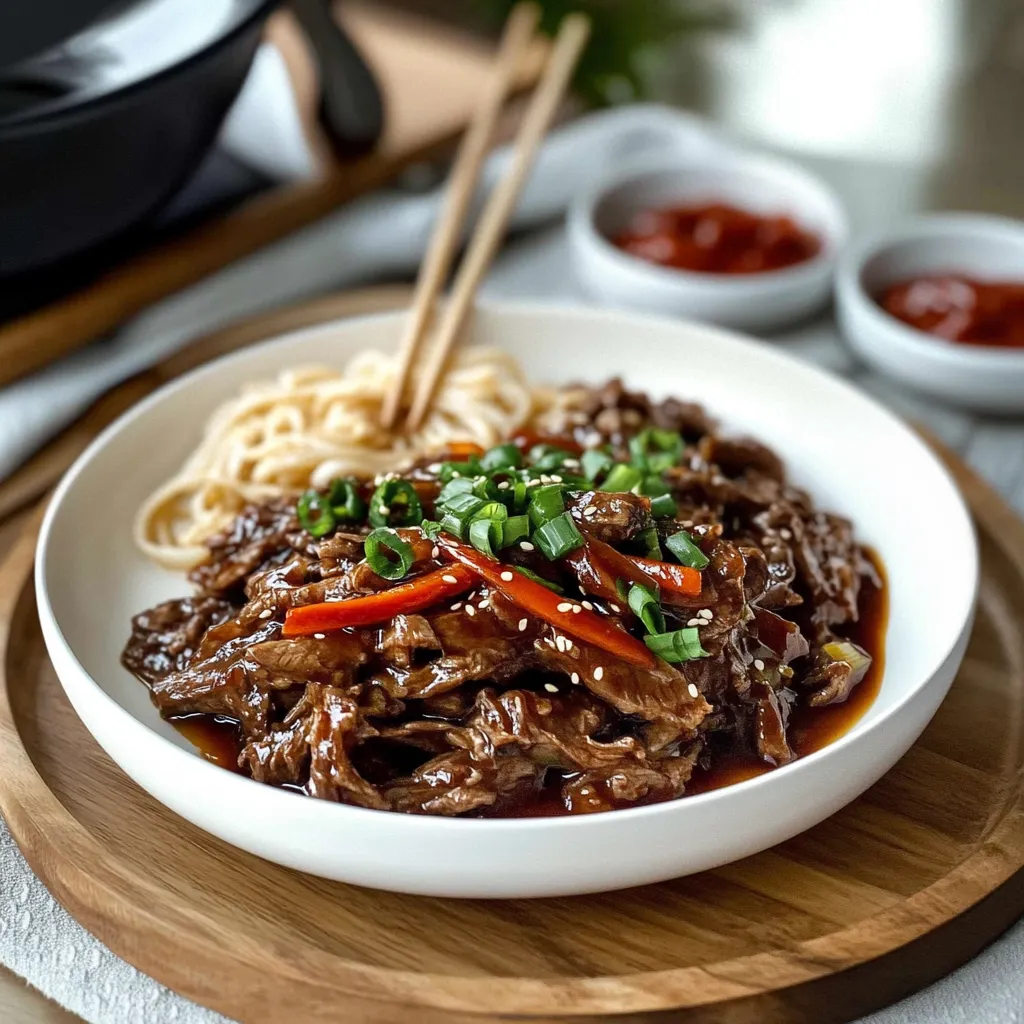
Slow Cooker Korean Beef Recipe Card
Ingredients:
-
3/4 cup reduced-sodium beef broth (divided)
-
1/2 cup reduced-sodium soy sauce
-
1/3 cup brown sugar (packed)
-
5 cloves garlic (minced)
-
2 tablespoons sesame oil
-
2 tablespoons rice vinegar
-
2 tablespoons grated fresh ginger
-
1-2 tablespoons Gochujang sauce
-
1/2 teaspoon onion powder
-
1/2 teaspoon black pepper
-
3-4 pounds boneless beef chuck roast (cut into 1-inch cubes)
-
1-2 tablespoons cornstarch (depending on desired sauce thickness)
Instructions:
-
Prepare the Sauce: In a medium bowl, whisk together 1/2 cup of beef broth, soy sauce, brown sugar, garlic, sesame oil, rice vinegar, ginger, gochujang sauce, onion powder, and black pepper until well combined.
-
Add Beef to Slow Cooker: Place the cubed beef chuck roast into the slow cooker.
-
Pour Sauce Over Beef: Pour the prepared sauce mixture over the beef cubes in the slow cooker. Stir to coat the beef evenly.
-
Cook: Cover and cook on low heat for 6-8 hours. Alternatively, cook on high for 4-5 hours.
-
Thicken Sauce: In a small bowl, whisk together the remaining 1/4 cup of beef broth and cornstarch. Stir this mixture into the slow cooker and cook on high for an additional 30 minutes or until the sauce thickens.
-
Serve: Once the beef is tender and the sauce is thickened, serve the Slow Cooker Korean Beef over rice, in tacos, or in bowls with fresh vegetables.
Notes:
-
Gochujang Sauce: Be sure to use gochujang sauce, not paste. The sauce is less concentrated, giving the dish the perfect balance of heat and sweetness.
-
Substitute for Gochujang Sauce: If you can’t find gochujang sauce, substitute with a mixture of soy sauce, Sriracha, and brown sugar



